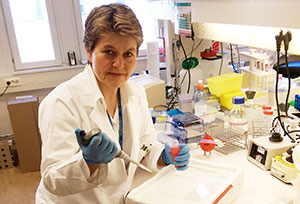Hardening of the arteries, also known as atherosclerosis, is the accumulation of fat, particularly cholesterol, and inflammatory cells inside blood vessels.
– It’s the main cause of disability and of reduced lifespan and quality of life in the Western world. Even with the good quality treatments available today, there is still a desperate need for better and more effective treatment, says Bente Halvorsen, Professor of Medicine at the University of Oslo (UiO) and head of department at Oslo University Hospital (OUS).
Along with researchers from OUS and the Norwegian University of Science and Technology (NTNU), the UiO professor is part of the international research group behind the study that may have the answer to this therapeutic need.
The study, which was published in Science Translational Medicine, shows that hardening of the arteries can be treated effectively with cyclodextrin, a form of sugar.

Dissolves deposits
Cyclodextrin is a complex sugar compound that is present in several drugs to improve their solubility and uptake.
Today, statins – drugs that reduce the production of cholesterol – and surgery are used to treat hardening of the arteries.
The cyclodextrin study suggests a potential treatment for several groups of patients with this condition. This is the first time researchers have had a possible drug that could be used to treat arteries that have already hardened:
– It’s probably a more effective treatment because cyclodextrin removes cholesterol deposits. The statins used in treatment today don’t do that, says Halvorsen, and adds:
– Surgery is not a therapeutic option for very many people, whereas cyclodextrin will probably be suitable for use by everyone.
Mother behind the idea
In addition to Halvorsen, Mona Skjelland at Oslo University Hospital, Rikshospitalet, and the NTNU have also taken part in the study. The study is led by Professor Eicke Latz at the University of Bonn.
Latz got the idea from a mother with two seriously ill daughters. Both girls had a disease that prevents the body from getting rid of cholesterol in the normal way.
The girls were given an experimental cyclodextrin treatment. This gave the mother the idea that the drug could also be used to help patients with hardening of the arteries.
Worldwide attention
The study, which was carried out in mice, has caught the attention of researchers worldwide. The research group has received several inquiries regarding the use of cyclodextrin in treatment. Halvorsen stresses that there is still a long way to go before a drug is available on pharmacy shelves.
– There are a lot of things to address before cyclodextrin could become standard treatment for diseases caused by hardening of the arteries. What clinical criteria should form the basis for treatment, what dose should we use and so on, are questions that must be answered. Furthermore, possible side effects and the effects of long-term treatment must be studied. Latz and my colleagues in Germany are already working on these important next steps, says Halvorsen.
OUS is planning a clinical study in collaboration with NTNU and Professor Latz in which the research group will include patients with hardening of the arteries in the neck. They’re now working to secure funding for the study which will verify the findings, a so-called proof of concept study.
Read the entire study in Science Translational Medicine.
